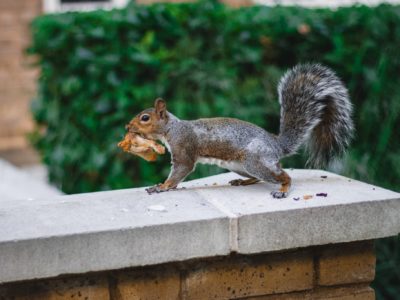I came close to tripping over the squirrel. He was lying spread-eagle on the sun-warmed brick walkway just ahead of me, eyes closed. I stared at him, tempted to ask, “Are you okay?” The gray squirrels on the University of North Carolina Chapel Hill campus were bold around humans, but I never saw one brave enough to nap in the middle of a traveled sidewalk.
The squirrel slowly opened one eye, and I saw a massive nut crammed into his mouth. He slowly chewed, then looked at me. It was the sort of look professors give to freshmen who raise their hands mid-lecture to ask if they can use the bathroom—a stare of disdain and disgust.
Once I was sufficiently glared at, the squirrel slowly dragged himself off to the side of the path. I awkwardly walked past, feeling his eyes still boring into me. The message was clear. I’m sunbathing and enjoying lunch, you idiot. You should be moving aside for me.
That incident was the first and only time I’ve felt personally judged and shamed by a squirrel.
It is also one of my favorite memories from college. For starters, it’s freaking hilarious. More importantly, it reminds me of one of the best things about my college: how the school incorporates the natural world. The wild animals I’ve met right outside my dorm have been fascinating, and they’ve been a good reminder of how a busy student can stay healthy and happy through contact with nature.
My school, UNC-Chapel Hill, has a campus filled with green spaces. Trees are planted through campus, courtyards are filled with grass instead of concrete, and we have our own arboretum. Those trees and gardens are homes for numerous wild animals, and I’ve benefited from my encounters with them.
Early in my freshman year, I discovered I was living next to an owl’s nest. I first realized it when I glanced at the dorm volleyball court and saw a dark silhouette perched on the net. It was too dark to see the color or pattern of the owl’s feathers, but the rounded head made me think it was a barred owl. The owl crouched there for several minutes, then flared its wings and vanished into the blackening sky. It was a simple encounter, but it made me happy to know that such a beautiful animal was thriving right next to me. Seeing the owl living its life made me briefly forget the worries of my own days, a kind of relief my often-stressed mind needed.
Science agrees with me (not to sound pompous). Contact with animals and nature does relieve stress and anxiety, many studies have found. Lynette Hart at the University of California, Davis, found that pets enhancements to a person’s quality of life. These benefits apply to interaction with wild animals and plants as well. The Department of Environmental Conservation reported that spending time in forests improves mood and mental focus, helps the immune system and reduces stress and blood pressure.
After the night I saw the owl, I began paying attention to the skies. I watch hawks and kestrels perching on power lines and gliding over the football stadium, and feel the same release from anxiety that the owl created in me. Different encounters have other, but equally valuable, effects on me. I discovered that the woodpeckers who lived in the pine grove near the dining hall sometimes left brown-and-white-spotted feathers on the ground. I took to scanning the woods for those feathers to collect. My search requires concentration, but it is a happy kind of concentration. Plus, it gets me to exercise in the fresh air and sunshine rather than lounge around indoors. (I found a number of beautiful feathers and I keep them in my room.)
If the birds of prey calm me and the woodpecker feathers give me a pleasant way to stay active, the school arboretum does both. Located on the edge of campus, the Coker Arboretum collects North Carolina plants. The trees, flowers, and ferns are helpfully labeled with their species, and it’s open to all comers all day long. The flowers vary by season, but roaming through the narrow pebbled paths and over the small wooden bridges is always a good exercise, and the atmosphere is peaceful enough that I don’t feel like I’m working my body.
The rest of campus is similarly relaxing. Over a hundred species of trees are planted throughout the college. Students plant and keep up gardens of vegetables for the dining halls.

Good health isn’t all relaxation or exercise, though. Laughter is good medicine, and I get a good deal of entertainment from the animals around me.
The gray squirrels are comfortable around students and dumpster diving experts. I often see fluffy tails pop out of trash cans next to me. I’ve even seen squirrels burying their faces in cups of ketchup.
A raccoon made a den in the storm drain near my dorm, and he can be seen squeezing his pudgy body through the bars of the drain. Occasionally he takes a walk and ends up being followed by students, who embarrass him by taking pictures that make him look fat.
I’m very fortunate to live on a campus that includes the natural world rather than destroying it. The animals and plants at UNC-Chapel Hill help me emotionally and improve my daily life. I wish all college students had the same opportunities to interact with nature and enjoy its benefits. If your campus does not have sufficient green space, though, you can take steps to find nature. Search for nearby parks and walking trails. Volunteer at animal shelters.
Most of all, keep your eyes open. The animals and plants that can do you the best may be living right outside your door.



















